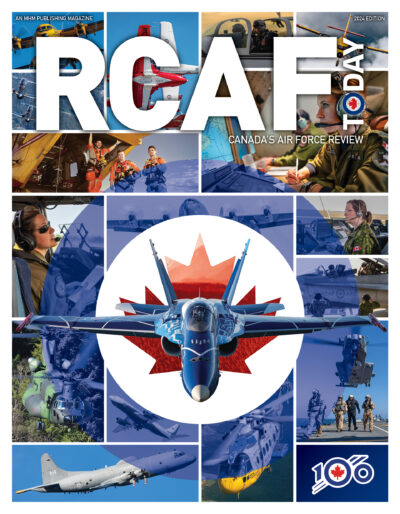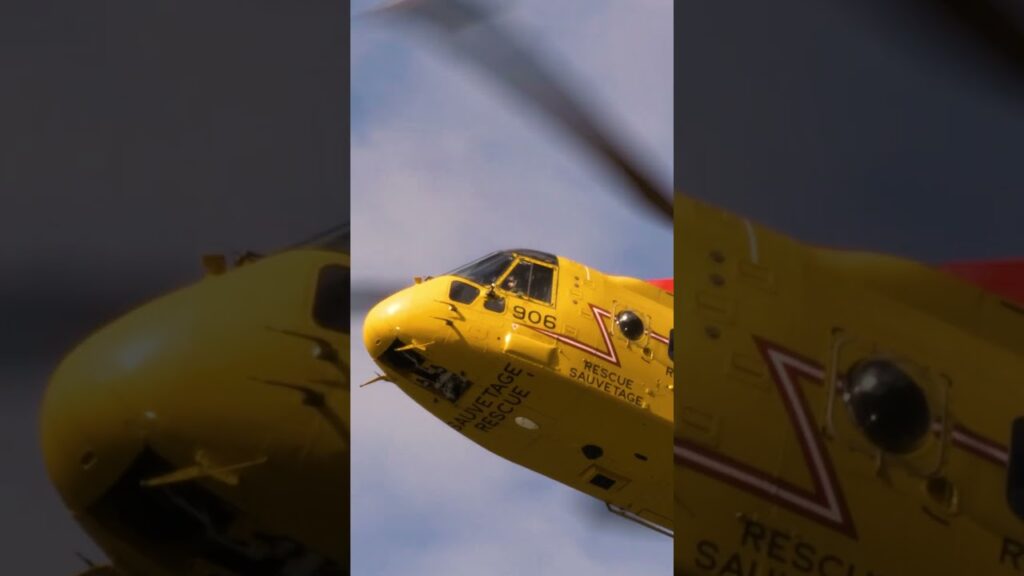
In the second half of 2018, the world’s leading businesses will have a new tool to help close major international deals. Andy Cline Photo
International business is synonymous with long distance travel.
In the second half of 2018, the world’s leading businesses will have a new tool to help close major international deals – the Bombardier Global 7000 business jet.
“This aircraft is the number one priority for Business Aircraft,” said David Coleal, the new president of Bombardier Business Aircraft who returned to the company in June.
Coleal said the Global 7000 offers customers an “unprecedented combination” of comfort, performance and flexibility.
The Global 7000 has been designed with a spacious cabin featuring four unique “living spaces” and a dedicated crew rest area, a new wing optimized for short field performance and exceptionally long range, a new fly-by-wire control system with side stick, and powerful new 16,500 pound thrust GE Passport turbofan engines.
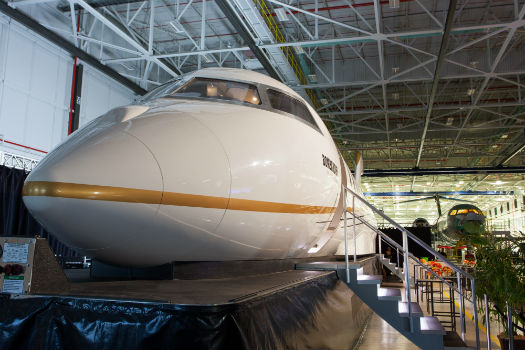
The Global 7000 cockpit cabin demonstrator was displayed for all to see, inside and out. Andy Cline Photo
When Bombardier announced the aircraft in 2010, its goal was to set the benchmark for a new category of large business jets, offering 20 per cent more living space than competitors.
To this end, the Global 7000 has the largest cabin in its class (54 feet, seven inches or 16.64 metres), a maximum speed of Mach 0.925 and a range of 7,400 nautical miles at M 0.85 (with eight passengers and four crew).
The Global 8000 will have a range of 7,900 nautical miles and three “living spaces” in a 45-foot, seven-inch (13.89 metre) long cabin.
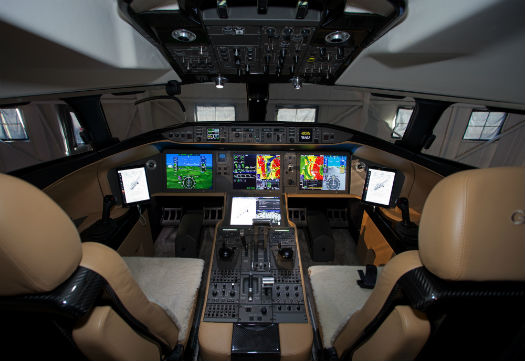
The advanced cockpit of the Global 7000 includes heads up displays. Andy Cline Photo
A Global 7000 cabin mockup was displayed with 12 to 19 seats adjacent to the first two Global 7000 flight test vehicles (FTV) which were undergoing systems integration, with components for third and fourth FTV also on site.
Bombardier first introduced fly-by-wire (FBW) systems on the CRJ1000 airliner and then the C Series, with the new Globals featuring side stick controllers.
A large number of test rigs have already been commissioned in Toronto, Montreal and partner facilities to support systems integration and certification.
The list price of a Global 7000 is US$72.8 million and a Global 8000 is US$69 million.
Flagship
The Global is the flagship of Bombardier’s business aircraft portfolio and a major source of its aerospace revenue.
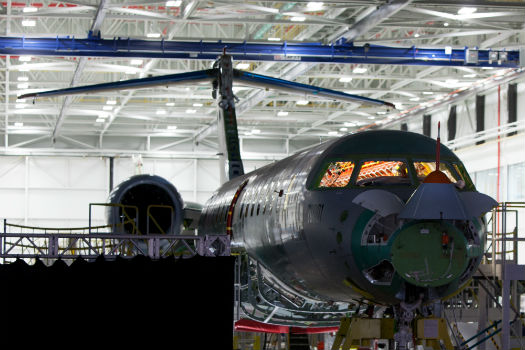
The Global 7000 and Global 8000 are designed to complement, not replace the current production Global 5000 and Global 6000. Andy Cline Photo
The prototype Global Express made its maiden flight at Bombardier-owned Downsview Airport Oct. 13, 1996 with more than 740 produced by November 2015.
The world financial crisis of 2008 hit business aircraft sales hard, but sales of aircraft like the Global actually increased.
Bombardier delivered 80 Global 5000 and Global 6000 aircraft in 2014, according the General Aviation Manufacturers Association (GAMA), up from 62 the year before.
In May 2015, Bombardier announced a reduction in Global production to 50-60 a year in light of weak demand in Russia, China and Latin America.

The world financial crisis of 2008 hit business aircraft sales hard, but sales of aircraft like the Global actually increased. Andy Cline Photo
Two months later, Bombardier announced the Global 7000 would enter service in the last half of 2018, not 2016 as originally planned.
State of the art
The Global 7000 and Global 8000 are designed to complement, not replace the current production Global 5000 and Global 6000.
Walk through Bombardier’s 157,935 square metre factory and Global 5000 and Global 6000 aircraft and components can be found in many production areas once exclusively used to build Q Series Dash 8 airliners. (Toronto continues to build the Q400 tuboprop, with the 500th delivered to WestJet in June).
The Toronto factory is seeing a step change in manufacturing technology with the arrival of the Global 7000, introducing state-of-the-art systems into the production bay.
Overhead cranes are used to unload large components from trucks as they arrive from global suppliers, but then the heavy lifting and precision work had been transferred to automated systems.
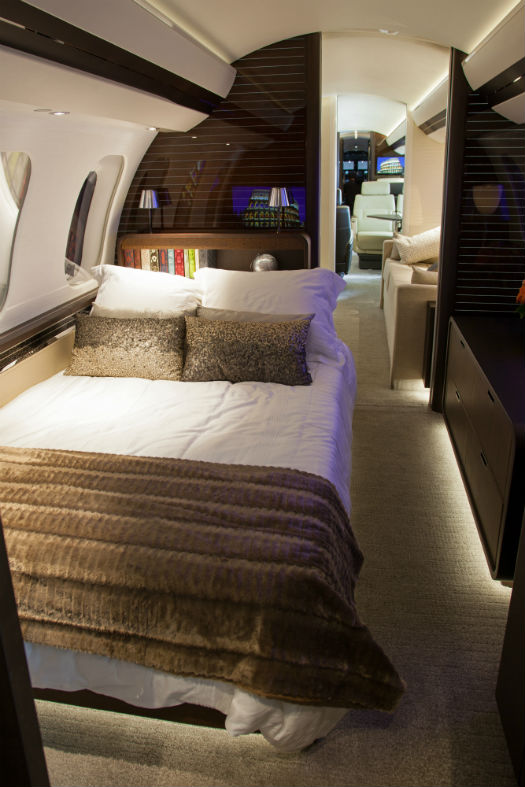
The Global 7000 has been designed with a spacious cabin featuring four unique “living spaces” and a dedicated crew rest area. Andy Cline Photo
This includes an automated positioning system that moves the wing structure into place for joining with the fuselage. This system uses laser-guided measuring to ensure components of the aircraft are joined consistently and perfectly each time.
Laser-guided technology is also a key feature of the final assembly line’s articulated robot drilling. Designed to ensure consistent quality and repeatability, the robot drilling features a tolerance for accuracy and precision within less than one thousandth of an inch.
The robots were used to precision-drill the holes to join centre fuselage to the cockpit and rear fuselage. As experience builds, robots will also be used for precision riveting.

The list price of a Global 7000 is US$72.8 million and a Global 8000 is US$69 million. Andy Cline Photo
The new production line is also paperless, with Windows tablets replacing paper worksheets at all stages of the production processes.
Many of the Tier 1 System integrators partnering with Bombardier are new to the Global program.
The wings are made in Texas by Triumph Aerospace, the fuselage in Mirabel, Que. by STELIA North America Assembly and Systems Integration (formerly Aerolia Canada), and Bombardier makes the Global cockpit in Montreal and the new tail and empennage in Querétaro, Mexico.
These upstream suppliers had to be part of the new manufacturing processes to ensure parts met the required tolerances and came with the data package required for full integration.
